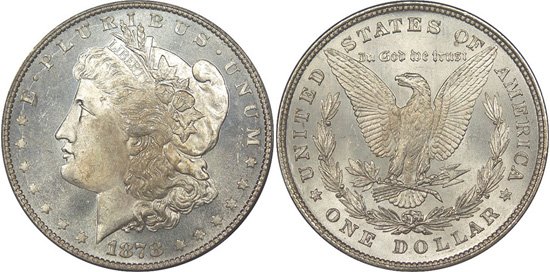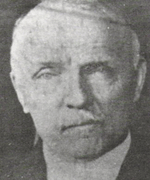Guide to U.S. Morgan Dollars
The Morgan Silver Dollar is frequently cited as the most popular series within all of American numismatics. Collectors are drawn to the large size, classic design, and relatively robust availability. The coins were issued from 1878 to 1904 and for one additional year in 1921, with production taking place across four different mint facilities.
Due to the high original Morgan Dollar mintages, many issues are readily available even in gem grades. However, certain issues of the series had low mintages or experienced heavy circulation and melting, resulting in a very limited number of survivors. Some coins also display Proof-Like or Deep Mirror Proof-Like qualities, adding another dimension to collecting the series. Consult the latest NGC Census Data for Morgan Silver Dollar populations.

Although the silver dollar had been regarded as the cornerstone of the American monetary system, during its early history the denomination experienced sporadic circulation and long interruptions in production. The Coinage Act of 1873 would discontinue the silver dollar and authorize the Trade Dollar, which carried different specifications and was intended primarily for export trade with Asia. Problems became apparent when the price of silver dropped and many Trade Dollars were reimported to the United States. Bullion depositors also began to have their silver struck into Trade Dollars, which they would distribute at a discount to face value. The coins became widely unpopular within the United States due to their legal tender limit and low intrinsic value, leading the Trade Dollar to be officially demonetized in 1876.
Morgan Dollar Legislation

In response to economic conditions and pressure from the silver mining industry, the Bland-Allison Act was passed in 1878 to restore the standard silver dollar. Specifically, the Act required the United States government to purchase between 2 and 4 million ounces of silver each month to be minted into silver dollars. The coins were struck under the specifications set forth in the Coinage Act of 1837 and legal tender for all debts and dues both public and private. The Act also created paper currency known as silver certificates, which were backed by the exact amount of silver dollars retained by the Treasury.
The new silver dollars would feature a design by George T. Morgan, an English-born immigrant. In England, he had studied and worked for the Wyon family, best known for their minting of several American colonial coinage issues. When he came to the United States in 1876, he was hired as the assistant engraver of William Barber and started working on a number of patterns for the half dollar. In late 1877, the Mint Director Henry Linderman instructed both Morgan and Barber to prepare dies for a silver dollar. Linderman favored the designs created by Morgan and production of the new silver dollars would commence on March 11, 1878, about a week after the passage of the Bland-Allison Act.
The obverse of the Morgan Dollar features the head of Liberty, facing left. The model for Liberty is believed to be Philadelphia schoolteacher Anna Willess Williams, who had sat for Morgan on several occasions. Liberty wears a Phrygian cap with the word “LIBERTY” on her hair band and various agricultural elements intertwined, including stalks of wheat, bolls of cotton, and leaves of oak. There are seven stars appearing to the left of the portrait and six stars appearing to the right. The inscription “E PLURIBUM UNUM” appears above, with the date below. The designer’s initial, appearing as a single “M,” is found on the truncation of the neck.
The reverse design features a bald eagle with its wings outstretched, framed within a small, open wreath. The eagle’s talons grasp an olive branch and three arrows. The inscription “IN GOD WE TRUST” appears above the eagle. The additional inscriptions “UNITED STATES OF AMERICA” and “ONE DOLLAR” appear surrounding, separated by stars.
From the onset of the series, the requirements of the Bland-Allison Act led to heavy silver dollar production, well in excess of the needs for commerce. By 1890, a total of 360 million silver dollars had been produced, of which only one-sixth was estimated to have been released into circulation. The remaining quantity was simply held in storage. The situation was exacerbated by the Sherman Silver Purchase Act, which increased the required government purchase of silver to 4.5 million ounces per month. Despite these large purchases, the price of silver dropped and the world entered a financial panic caused in part by the silver issue. President Grover Cleveland responded to the situation by repealing the Sherman Silver Purchase Act.
Without the required government purchases of silver, the production of silver dollars promptly declined, leading to the creation of numerous low mintage issues. The production of silver dollars would cease completely in 1904 since the government already held millions in storage which were not needed for circulation. The landscape would change once again with the passage of the Pittman Act in 1918. This Act allowed for up to 350 million silver dollars held in storage to be melted and converted into bullion. The same quantity melted was required to be replaced with newly minted silver dollars struck with silver from other sources.
Under the Pittman Act, a total of 230,232,722 silver dollars held in storage were melted. This massive melt had a significant impact on the rarity and availability of certain issues of the Morgan Dollar series. Some dates with high mintages became scarcer, while some issues with seemingly low mintages remained available. The Act had the additional impact of restarting the production of Morgan Dollar for a single year in 1921, when more than 80 million pieces were struck across three mint facilities. The Peace Dollar series would be introduced at the end of the year and used to fulfill the remaining production required under the Pittman Act.
Frequently Asked Questions
The Morgan Dollar was struck by the U.S. Mint from 1878 to 1921 and has been struck from 2021 to the present day.
The metal content of the Morgan Dollar from 1878 to 1921 is 90% silver and 10% copper. The metal content of the Morgan Dollar from 2021 to the present day is 99.9% silver.
The Morgan Dollar’s weight is 0.8594 troy ounces (26.730 g).
The diameter of the Morgan Dollar is 1.500 inches (38.10 mm).
The Morgan Dollar was designed by George T. Morgan in 1878.

